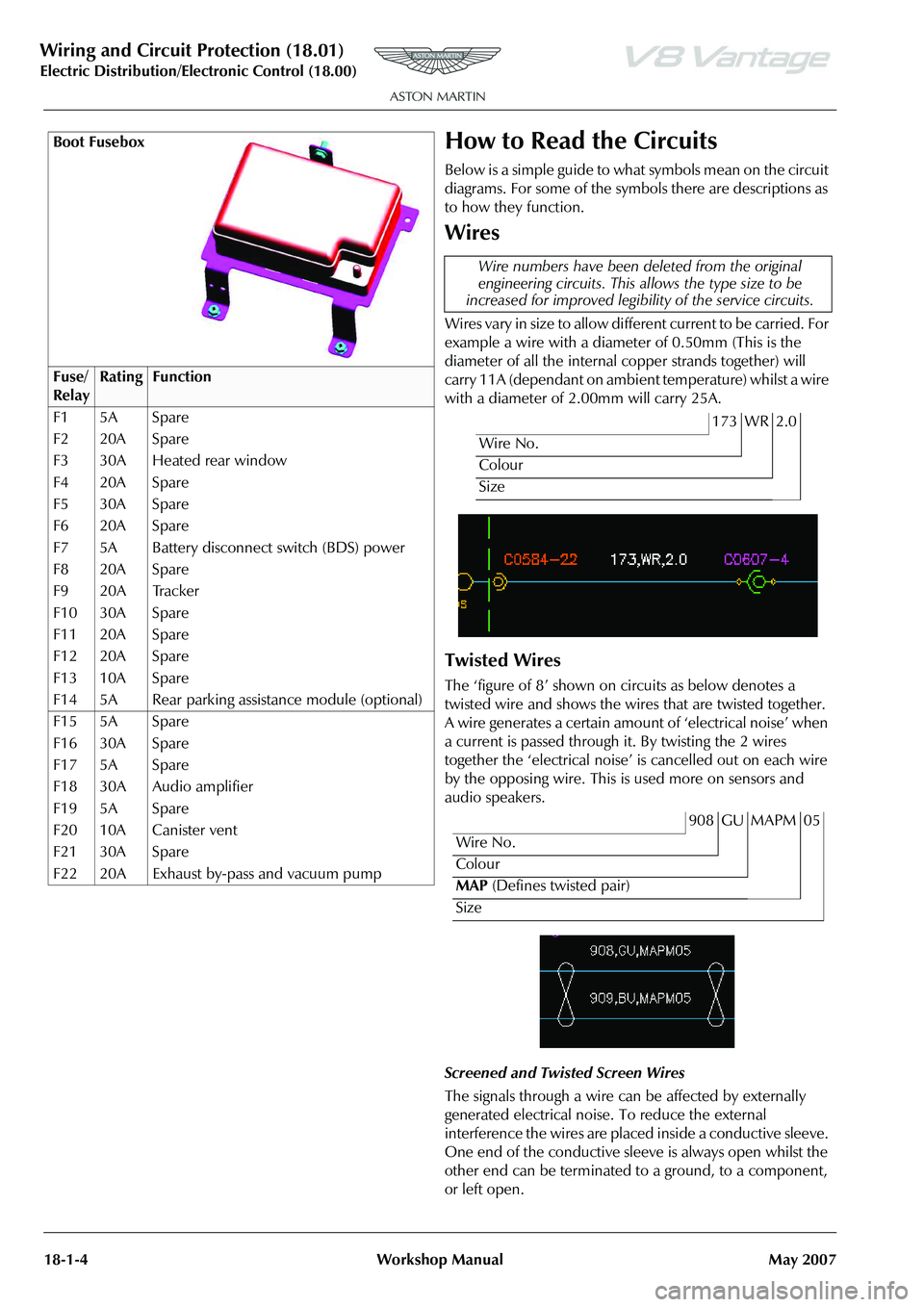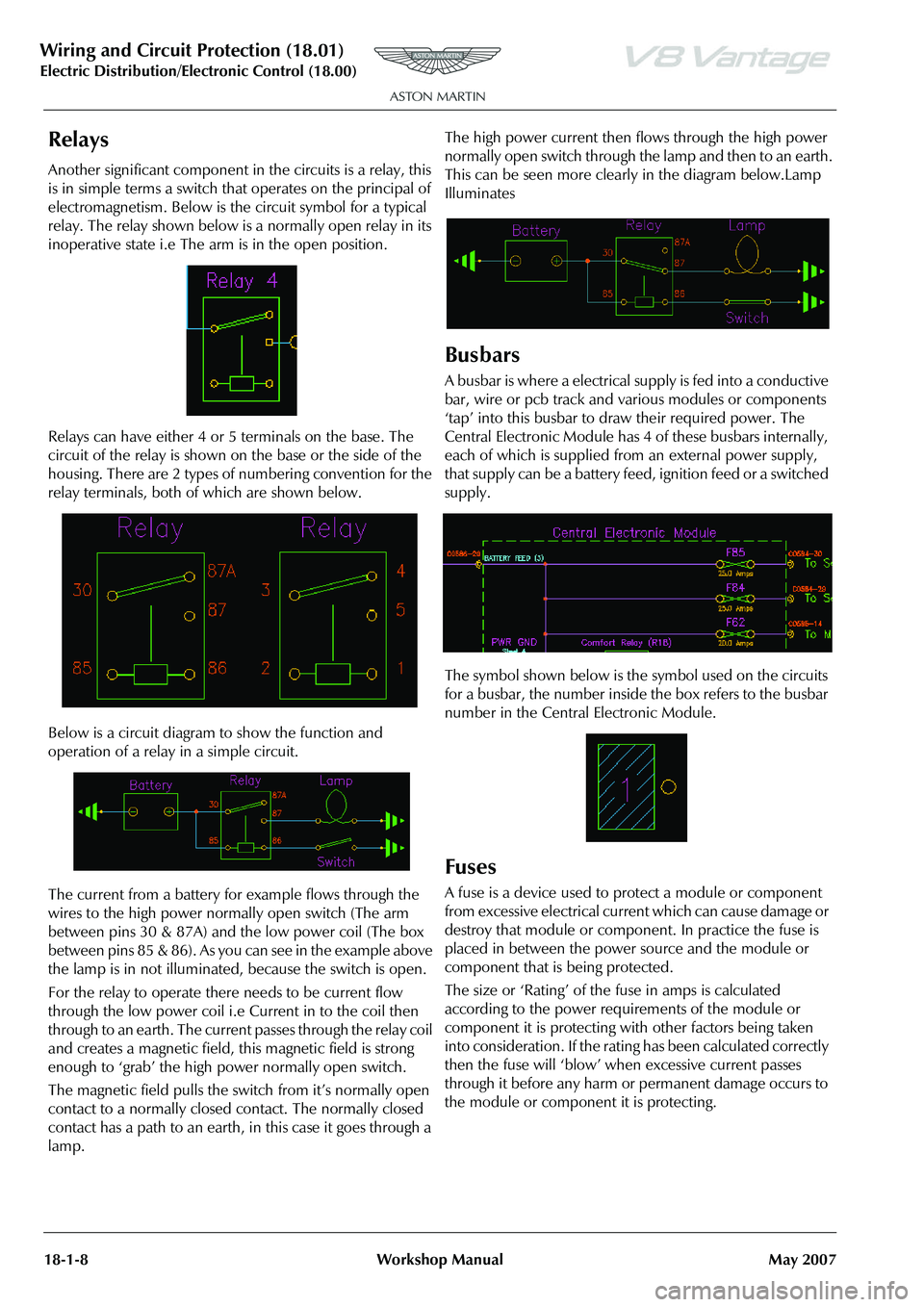wiring diagram ASTON MARTIN V8 VANTAGE 2010 Workshop Manual
[x] Cancel search | Manufacturer: ASTON MARTIN, Model Year: 2010, Model line: V8 VANTAGE, Model: ASTON MARTIN V8 VANTAGE 2010Pages: 947, PDF Size: 43.21 MB
Page 693 of 947

Wiring and Circuit Protection (18.01)
Electric Distribution/E lectronic Control (18.00)
18-1-4 Workshop Manual May 2007
How to Read the Circuits
Below is a simple guide to what symbols mean on the circuit
diagrams. For some of the symbols there are descriptions as
to how they function.
Wires
Wires vary in size to allow diffe rent current to be carried. For
example a wire with a diamet er of 0.50mm (This is the
diameter of all the internal copper strands together) will
carry 11A (dependant on ambient temperature) whilst a wire
with a diameter of 2.00mm will carry 25A.
Twisted Wires
The ‘figure of 8’ shown on circuits as below denotes a
twisted wire and shows the wires that are twisted together.
A wire generates a certain amount of ‘electrical noise’ when
a current is passed through it. By twisting the 2 wires
together the ‘electrical noise’ is cancelled out on each wire
by the opposing wire. This is used more on sensors and
audio speakers.
Screened and Twisted Screen Wires
The signals through a wire can be affected by externally
generated electrical noise. To reduce the external
interference the wires are placed inside a conductive sleeve.
One end of the conductive sleeve is always open whilst the
other end can be terminated to a ground, to a component,
or left open.
Boot Fusebox
Fuse/
RelayRatingFunction
F1 5A Spare
F2 20A Spare
F3 30A Heated rear window
F4 20A Spare
F5 30A Spare
F6 20A Spare
F7 5A Battery disconnect switch (BDS) power
F8 20A Spare
F9 20A Tracker
F10 30A Spare
F11 20A Spare
F12 20A Spare
F13 10A Spare
F14 5A Rear parking assistance module (optional)
F15 5A Spare
F16 30A Spare
F17 5A Spare
F18 30A Audio amplifier
F19 5A Spare
F20 10A Canister vent
F21 30A Spare
F22 20A Exhaust by-pass and vacuum pump
Wire numbers have been deleted from the original
engineering circuits. This al lows the type size to be
increased for improved legibil ity of the service circuits.
173 WR 2.0
Wire No.
Colour
Size
908 GU MAPM 05
Wire No.
Colour
MAP (Defines twisted pair)
Size
Page 697 of 947

Wiring and Circuit Protection (18.01)
Electric Distribution/E lectronic Control (18.00)
18-1-8 Workshop Manual May 2007
Relays
Another significant component in the circuits is a relay, this
is in simple terms a switch that operates on the principal of
electromagnetism. Below is the circuit symbol for a typical
relay. The relay shown below is a normally open relay in its
inoperative state i.e The arm is in the open position.
Relays can have either 4 or 5 terminals on the base. The
circuit of the relay is shown on the base or the side of the
housing. There are 2 types of numbering convention for the
relay terminals, both of which are shown below.
Below is a circuit diagram to show the function and
operation of a relay in a simple circuit.
The current from a battery for example flows through the
wires to the high power normally open switch (The arm
between pins 30 & 87A) and the low power coil (The box
between pins 85 & 86). As you can see in the example above
the lamp is in not illuminated, because the switch is open.
For the relay to operate there needs to be current flow
through the low power coil i.e Current in to the coil then
through to an earth. The current passes through the relay coil
and creates a magnetic field, this magnetic field is strong
enough to ‘grab’ the high power normally open switch.
The magnetic field pulls the switch from it’s normally open
contact to a normally closed contact. The normally closed
contact has a path to an earth, in this case it goes through a
lamp. The high power current then flows through the high power
normally open switch through the lamp and then to an earth.
This can be seen more clearly in the diagram below.Lamp
Illuminates
Busbars
A busbar is where a electrical
supply is fed into a conductive
bar, wire or pcb track and various modules or components
‘tap’ into this busbar to draw their required power. The
Central Electronic Module has 4 of these busbars internally,
each of which is supplied from an external power supply,
that supply can be a battery feed, ignition feed or a switched
supply.
The symbol shown below is the symbol used on the circuits
for a busbar, the number inside the box refers to the busbar
number in the Central Electronic Module.
Fuses
A fuse is a device used to protect a module or component
from excessive electrical current which can cause damage or
destroy that module or component. In practice the fuse is
placed in between the power source and the module or
component that is being protected.
The size or ‘Rating’ of the fuse in amps is calculated
according to the power requirements of the module or
component it is protecting with other factors being taken
into consideration. If the rating has been calculated correctly
then the fuse will ‘blow’ when excessive current passes
through it before any harm or permanent damage occurs to
the module or component it is protecting.
Page 698 of 947

Wiring and Circuit Protection (18.01)
Electric Distribution/Electronic Control (18.00)
May 2007 Workshop Manual 18-1-9
In a correctly protected circuit, the fuse is placed ‘ Inline’
between the power source in this case the battery and the
lamp. If the lamp goes ‘short circuit’, a massive current will
begin to flow and the fuse will fail causing an open circuit.
The battery and wiring are protected from over current
damage.
Below is the fuse symbol as shown on the circuit diagrams.
The number above the fuse symbol is the fuse number;
allocated to this fuse. The number below the fuse symbol is
the rating.
Resistors
A resistor is an electronic component that by way of its
construction reduces the current flowing through it. A
resistors unit of measure is the Ohm.
The diagrams below show a resi stor and a variable resistor.
Variable Resistors
A variable resistor works in the same manner as a normal
resistor but the resistance values can fluctuate. The
construction of a variable resi stor depends upon its use and
environment.
One example is for the fuel tank level sensor. The tank full
level is 10 ohms and the tank empty level is 204 ohms, the
resistance will vary between 10 and 204 ohms depending on
how much fuel is in the tank.
Lamps
Below is the symbol for a light bulb, shown below the
symbol is the power of the bulb in watts.
Switches
There are numerous of types of switch, several of examples
are shown below.
Normally Open Switch
2 Position Switch
3 Position Switch
Motors and Pumps
The same symbol is used for a pump or a motor, the
description differentiates between them.
Pump
Page 699 of 947

Wiring and Circuit Protection (18.01)
Electric Distribution/E lectronic Control (18.00)
18-1-10 Workshop Manual May 2007
Motor
Diodes
The simplest way of describing a diode is ‘a non return
valve’. The current will flow through the diode from the
anode to the cathode, due to the construction of it though
current cannot come back. Diodes are used to reduce the
possibilities of ‘back feed’. This is where current comes
through the circuit the wrong way for one reason or another.
Below is the circuit symbol for a diode.
Light Emitting Diode (LED)
The light emitting diode (LED) works on the same principal
as the diode. The main difference is that in the
manufacturing process one of the materials is replaced by
another. This replacement mate rial has certain properties
that when a certain voltage passes through it glows.
Transistor
A transistor in simplistic term s is a switch with no moving
parts. The ‘switching’ is controlled by electronics and
currents etc. rather than a physical switch being operated.
Below is the circuit symbol for it. The example shown below
is one of the most common basic type used called a
‘Bipolar’.
Field Effect Transistor (FET)
A field effect transistor (FET) is, in simplistic
terms, a switch with no moving parts. The
‘switching’ is controlled by electronics and
currents etc. rather than a physical switch
being operated. The main difference
between this and the type of transistor shown above is this
one operates using a magnetic field.
Earth / Ground
For an electrical current to ‘flow’ around a circuit it has to
start from a power source and go to an earth / ground. If
there are any breaks in this circ uit then current will not flow,
this is called an ‘Open circuit’
There are 2 types of earth, Signal Earth and Chassis Earth,
these are referred to sometimes as a Quiet Earth and Noisy
Earth respectively.
Some sensors for example specify a Signal / Quiet Earth.
While components such as pumps and motors can have a
Chassis / Noisy Earth. The reason behind this is that pumps,
motors and the like can generate ‘electrical noise’ by the
way of their operation. Some of this ‘electrical noise can be
transferred through wires, it is this ‘electrical noise’ that can
have an adverse effect on sensor signals and affect the
control readings.
Keeping Signal / Quiet and Chassis / Noisy
earths separate reduces th e effect of ‘electrical
noise’ being transferred from component to
component.
This symbol is a standard symbol for earths.
On the circuit diagrams some earths are shown as eyelets
with the description of Earth-**** next to it, the earths also
comply with the 4 digit C number. An example of this is
shown below.
=Anode Cathode
Anode Cathode
LED Colour
Arrow Symbol
indicating light
emission
Page 810 of 947

Electronics Training Programme
CONTENTS
INTRODUCTION 7
Description 9
SYSTEM LAYOUT 11
V8 Vantage Layout 11
DB9 Layout 13
INPUTS 15
V8 Vantage Power Supplies 15
DB9 Power Supplies 15
V8 Vantage Signal Inputs 15
DB9 Signal Inputs 15
Screens 15
OUTPUTS 17
V8 Vantage Outputs to Amplifier 17
DB9 Outputs To Amplifier 17
LED Indicator Outputs 17
SYSTEM OPERATION 19
Controls 19
Getting Help 21
Connecting A Phone 21
Selecting a Phone 22
List Paired Phones 22
Removing A Paired Phone 22
Removing All Phones 22
Making Calls 23
Answering Incoming Calls 25
Ending Calls 25
Transfer A Call 25
Rejecting A Call 25
Mute A Call 26
Un-mute A Call 26
Call Waiting 26
Touch-Tone System 26
Bluetooth Contact List 27
Switching Voice Prompts On/Off 28
Selecting A Language 28
DIAGNOSTICS 31
V8 Vantage Connector Pin Allocation 31
DB9 Connector Pin Allocation 32
Troubleshooting 33
V8 Vantage Wiring Diagrams 35
DB9 Wiring Diagrams 39
APPENDIX 1
APPENDIX 2
5